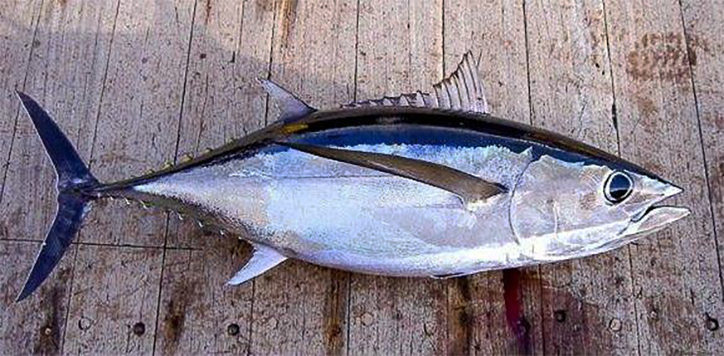Fish of the Thunnus genus of the tribe Thunnini of the subfamily Scombrinae of the Scombridae family of the Scombroidei suborder of the Scombriformes order of the Percomorpha clade of the Acanthopterygii superorder.

(Albacore. Photo © Muséum national d’Histoire naturelle (S. Iglesias). fishbase.org)
Albacore or longfin tuna (Thunnus alalunga) was first described in 1788 by the French abbot and naturalist Pierre Joseph Bonnaterre (1752-1804).
It is a pelagic schooling species. It inhabits the depths of up to 600 meters. The maximum recorded length is 140 cm, specimens up to 100 cm long are more common. The maximum weight is 60,3 kilograms. It feeds on fish, crustaceans, and squid.

(Albacore. Photo © The Online Guide to the Animals of Trinidad and Tobago. findeatdrink.com)
It is a rare inhabitant of the Adriatic Sea, more commonly found in its southern part.
It is put on the IUCN Red List as a near threatened (NT) species.
Names of albacore (Thunnus alalunga) in other languages are as follows:
Ton pendgjate (Albanian), Дългопера риба тон (Dilgopera riba ton) (Bulgarian), Witte tonijn (Dutch), Τόνος μακρόπτερος (Tonos macropteros) (Greek), Garmon (Hebrew), Atún blanco (Spanish), Alalunga (Italian), Weißer Thun (German), Tuńczyk biały, Tuńczyk albakora (Polish), Atum voador (Portuguese), Длиннопёрый тунец (Dlinnopjoryj tunets), Альбакор (Aljbakor) (Russian), Albakor, Tuna dugokrilac (Serbian, Croatian), Beli tun (Slovenian), Ton balığı (Turkish), Germon (French), Tuňák křídlatý (Czech).